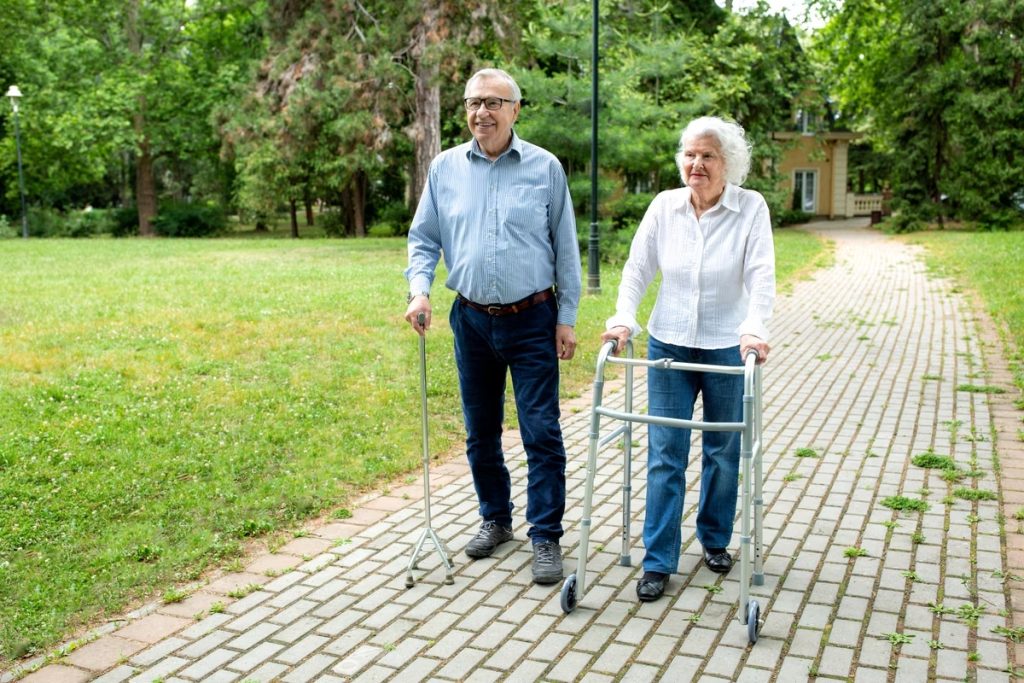As we age, mobility challenges can arise, and tools like canes and walkers become valuable aids to maintain independence and safety. These devices provide balance, stability, and confidence, allowing seniors to move freely without fear of falling. However, using a cane or walker properly is essential to get the most benefit and avoid unnecessary strain or discomfort.
Here’s a comprehensive guide to using canes and walkers correctly, so you can stay active and safe while enjoying your day-to-day life.
Choosing the Right Mobility Aid
Before you begin using a cane or walker, it’s important to choose the one that best suits your needs. A cane is suitable for individuals who need mild to moderate support and balance assistance. Walkers, on the other hand, provide greater stability and are ideal for those with more significant mobility challenges or who need extra support when walking.
Consulting a healthcare provider or physical therapist is the best way to determine which mobility aid is right for you. They can assess your needs and ensure you select the correct type, size, and style.
Adjusting Your Cane or Walker
The proper adjustment of your cane or walker is crucial for comfort and effectiveness. For canes, the handle should be level with your wrist when you’re standing upright with your arms relaxed at your sides. This position allows for a slight bend in your elbow when holding the cane, providing maximum support without straining your arm or wrist.
For walkers, the hand grips should also align with your wrists when your arms hang naturally by your sides. Standing upright while gripping the walker ensures good posture and reduces the risk of back pain.
If your cane or walker feels too high or low, don’t hesitate to adjust it. Many modern devices have adjustable features to help you find the perfect fit.
Using a Cane Properly
When using a cane, it’s important to hold it in the hand opposite the leg that needs support. For example, if your right leg is weaker or painful, hold the cane in your left hand. This technique helps distribute weight evenly and improves balance.
As you walk, move the cane forward at the same time as your weaker leg. Then, step forward with your stronger leg, placing it ahead of the cane. This rhythm creates a smooth and stable gait, reducing stress on your joints and muscles.
Take your time, and don’t rush your steps. A steady pace will help you stay balanced and avoid unnecessary strain.
Walking with a Walker
Walkers provide more support than canes, making them a great option for seniors who need extra stability. To use a walker properly, stand upright and grip the handles with both hands. Move the walker forward a short distance, ensuring all four legs or wheels are securely on the ground before taking a step.
Step forward with your weaker leg first, followed by your stronger leg. Keep your movements slow and steady, and avoid leaning too far forward or backward. Maintaining an upright posture will help you stay balanced and reduce strain on your back and shoulders.
If your walker has wheels, ensure they roll smoothly and that the brakes function correctly. Regularly check for any signs of wear or damage to keep your walker safe and reliable.
Maintaining Good Posture
One of the most important aspects of using a cane or walker is maintaining good posture. Slouching or leaning too heavily on your mobility aid can lead to discomfort and even long-term issues like back pain or muscle strain.
When walking with a cane or walker, keep your shoulders relaxed, your back straight, and your head up. Focus on looking ahead rather than down at your feet. This posture helps you maintain balance and reduces the risk of falls.
Navigating Stairs and Uneven Surfaces
Using a cane or walker on stairs or uneven surfaces requires extra caution. If you’re using a cane, always lead with your stronger leg when going up stairs and your weaker leg when going down. Use the handrail for additional support if one is available.
Walkers are not designed for stairs, so if you encounter stairs, you may need to rely on a railing or seek assistance. For uneven surfaces, move slowly and ensure your cane or walker is stable before taking each step.
Staying Safe While Using Mobility Aids
To ensure safety, always use your cane or walker as intended. Avoid carrying heavy objects while using a walker, as this can throw off your balance. If you need to carry items, consider attaching a small basket or bag to your walker.
Wear comfortable, non-slip shoes to reduce the risk of slipping or tripping. Keep your walking paths clear of clutter, and ensure your home is well-lit to help you navigate safely.
Regular Maintenance and Care
Keeping your cane or walker in good condition is essential for safety and reliability. Regularly inspect your mobility aid for signs of wear, such as loose screws, worn-out rubber tips, or damaged wheels. Replace any worn parts promptly to ensure your device remains safe and effective.
Clean your cane or walker regularly to remove dirt and debris, especially if you use it outdoors. Proper care will help extend the life of your mobility aid and keep it functioning at its best.
Conclusion
Using a cane or walker properly can significantly improve your mobility, balance, and overall quality of life. By choosing the right device, adjusting it to fit your needs, and practicing good posture, you can walk with confidence and ease.
Remember that safety and comfort come first. Take your time, move at a steady pace, and don’t hesitate to ask for help or guidance if needed. With the right approach, your cane or walker can become a trusted companion that helps you stay active and independent for years to come.

